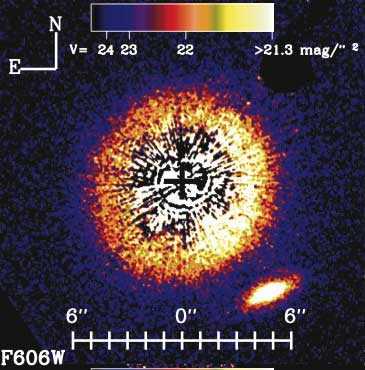
HD 107146
SAO 100038 HIP 60074
RA (2000) = 12 19 06.502
Dec (2000) = +16 32 53.863
SpT = G2V
V = 7.07mag d = 28.51 pc
Proper Motion (mas/yr) = -174.16 -148.90
This is an optical Hubble Space Telescope image of dust scattered
light (reflection nebulosity) around the G2V star HD 107146.
The central star is actually blocked by a small black spot
in the optical path of Hubble's camera, producing an artificial
eclipse of the star, and thus revealing the faint surrounding material that
is illuminated by the star.
In contrast to the other debris disks, this is the first
resolved image of a disk around a star like the Sun. However, at a distance of
28.5 pc (94 light year), HD 107146 is significantly farther away
than Beta Pic, Vega, Fomalhaut, etc.
The elliptical object seen to the lower right of HD 107146 is a
background galaxy.
The dust around HD 107146 appears to
be something like a donut in shape, because the disk is
inclined almost face-on to our line of sight (actually, 25 degrees
from face-on). The disk is seen as close as 60 AU from the star,
and the dust is concentrated at approximately
130 AU radius. The outer radius is approximately 185 AU.
Basic facts about HD 107146
1) structure is a ring with inner and outer radii of 60 and 185 AU, respectively.
2) scattered light color is red relative to the star (V - I = 0.4 mag).
3) the characteristic dust temperature is 40 - 50 K.
4) total dust mass is 0.1 - 0.4 Earth mass
5) asymmetric brightness distribution can be simulated by an asymmetric
scattering phase function such as a Henyey-Greenstein function with asymmetry
parameter = 0.2 - 0.3.
6) ring is seen 25 degrees from face-on from our point of view.